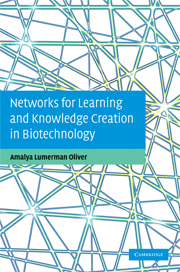Book contents
- Frontmatter
- Contents
- List of figures
- List of tables
- Acknowledgements
- Introduction
- 1 Networks, collaborations, and learning and knowledge creation
- 2 The biotechnology industry through the lenses of organizational and networks scholarship
- 3 New organizational forms for knowledge creation in biotechnology
- 4 Scientific entrepreneurship
- 5 Science and discoveries in the context of private and public knowledge creation and learning
- 6 The search for university–industry collaborations: linear and chaotic networking processes
- 7 Trust in collaborations and the social structure of academic research
- 8 Organizational learning and strategic alliances: recombination and duality of competition and collaboration
- 9 Further directions for understanding interorganizational collaborations and learning
- References
- Index
Introduction
Published online by Cambridge University Press: 04 July 2009
- Frontmatter
- Contents
- List of figures
- List of tables
- Acknowledgements
- Introduction
- 1 Networks, collaborations, and learning and knowledge creation
- 2 The biotechnology industry through the lenses of organizational and networks scholarship
- 3 New organizational forms for knowledge creation in biotechnology
- 4 Scientific entrepreneurship
- 5 Science and discoveries in the context of private and public knowledge creation and learning
- 6 The search for university–industry collaborations: linear and chaotic networking processes
- 7 Trust in collaborations and the social structure of academic research
- 8 Organizational learning and strategic alliances: recombination and duality of competition and collaboration
- 9 Further directions for understanding interorganizational collaborations and learning
- References
- Index
Summary
The biotechnology industry has been characterized by a wealth of interorganizational collaborations and networks for learning, a feature that resulted in and contributed to the high level of innovation in the industry. In this industry, scientists in the biological sciences developed drugs, diagnostics, waste management systems, agricultural products, or veterinary procedures through various intra- and interorganizational collaborations. These dense and crucial collaborations contributed to some unique features of industry structure, of types of organizations operating in the industry, and of the scientists involved in the process of scientific discoveries.
This book offers insights into organizational processes, structures, and outcomes which are associated with these networks of collaborations. The insights are based on integration of several “recombination features” of organizational elements that emerged in the biotechnology industry. In many respects, the emerged organizational structure of the industry is isomorphic with the central initial technology-invented recombinant DNA (rDNA). Thus, the book focusses on the following general question: How does our understanding of institutions, organizations, goals, learning, intellectual property rights, and collaboration forms contribute to our understanding of the emerging networks?
Hence, based on previous and ongoing research, the book highlights the following elements of recombination.
- Type
- Chapter
- Information
- Networks for Learning and Knowledge Creation in Biotechnology , pp. xiii - xviiiPublisher: Cambridge University PressPrint publication year: 2009



